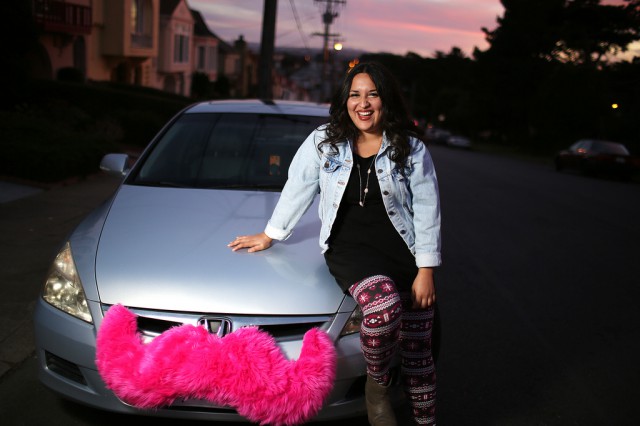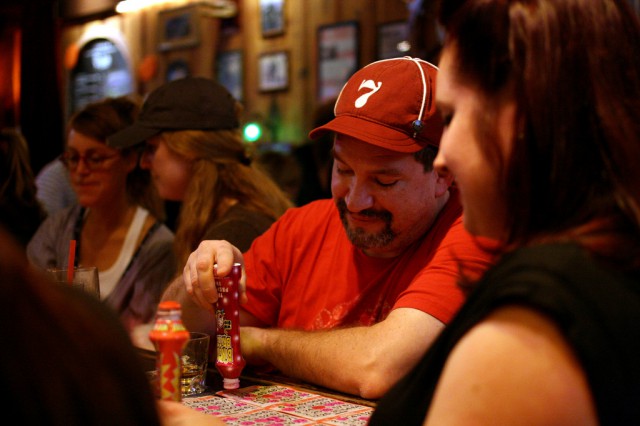
Written by Erika Maldonado
Photos by Benjamin Kamps
Janelle White is everything you’d want and expect a lecturer in SF State’s women and gender studies department to be.
Her salt and pepper curls fall naturally and wildly with hints of light blue along her temples. The blue dye on either side of her hair perfectly complements the blue tint on the frames of her glasses. Morning glory flowers envelop her right arm with Lizz Wright lyrics and sparrows peeking out through the stems. She wanted a full sleeve by her fortieth birthday, but she doesn’t seem to like to show them off.

A calm demeanor and the soothing tone of her voice invites open and honest conversation during class discussions. When she isn’t enlightening students on women, prison and the industrial complex on Mondays in the Humanities Building, she’s the executive director of San Francisco Women Against Rape. This year marks its fortieth anniversary and White helped organize the anniversary celebration held on Oct. 24.
“It fundamentally shaped who I was as a thinker, as an activist and an advocate,” says White. “I saw in action what it looks like when your mission is to end oppression so that you can end rape. I hadn’t seen that ideology practiced at a rape crisis center.”
SFWAR is one of many organizations housed in the Mission’s eye-catching Women’s Building. Located on 18th street, the entire four-story building is covered in murals. Portraits of influential women such as Rigoberta Menchu, Georgia O’ Keefe and Audre Lorde peer over passersby within the melange of radiant yellows, blues, reds and greens.
Inside, the female-led community space empowers, educates and provides a safe space for women and girls from all walks of life. SFWAR shares an atrium

with other organizations on the third floor. Natural light reflects from skylights onto the hardwood floors and a neon light fixture in the shape of a vagina hangs on the exposed brick wall.
“It’s not about charity work,” says White. “This is our community doing our own community work. What I’ve seen with SFWAR over the years is more clarity about the communities who need our support and figuring out ways to support them.”
The center provides one-on-one counseling, support groups, a twenty-four hour rape crisis hotline and prevention education. It’s more than just a safe place for survivors of domestic violence and sexual assault, says director of community initiatives Sandra Sandoval. Staff members are out on the field daily at schools, businesses and health clinics throughout the city presenting workshops on anything from sexual harassment, assault, anti-oppression, Internet violence to healthy relationships. They also table numerous events including SF State’s production of The Vagina Monologues. Staff also serve as advocates by accompanying women to court cases and doctor visits.
The anniversary celebration took place during domestic violence awareness month. President Obama called it a national holiday in a proclamation last year, but it’s been celebrated since 1987. Since sexual assault falls under the umbrella of domestic violence, SFWAR is celebrating its anniversary in October. White has worked in the movement to end violence against women for almost twenty years. Like many women involved in the movement, she is a sexual assault survivor.
“I didn’t tell anyone about it for about a year after it happened,” says White. “Once I had done my own kind of healing, I knew I wanted to work in this movement. I felt like there was a place for me. It just made sense.”
She was a twenty-four-year old graduate student at University of Michigan. It happened inside, in a place where she thought she was supposed to be safe. And it happened by someone she knew.
Women between the ages of eighteen and twenty-four are more likely to experience intimate partner violence than any other age group, according to the California Partnership to End Domestic Violence. On college campuses across the country, one in four women will be the victim of sexual assault.
“It’s so important for people to be able to talk about their assault,” says White. “Women tend to just stuff it for so long. They don’t tell anybody, and it’s very sad. It has a way of eating away at you.”

On campus, The SAFE Place is a resource for survivors of sexual assault, domestic violence, sexual harassment and stalking. Students can visit the Safe Place, located in the Student Services Building Monday through Friday. Since half of all sexual assaults committed during college years involve alcohol consumption by either the perpetrator or victim, the SAFE Place’s prevention course focuses on alcohol use and its role in sexual assaults. The second focus involves the role men play in sexual assault prevention.
“In the past, violence against women was considered a woman’s issue when in fact, men were perpetrating this violence,” says Ismael de Guzman, SFSU prevention education specialist. “Shouldn’t we be part of that solution? Shouldn’t we be part of that conversation?”
His program, Men Can Stop Violence is one of few CSU campuses that incorporates men in its sexual assault prevention program.
As White rounds out her twentieth year of work in the movement to end violence against women, she hopes to continue to build up other advocates to one day fill her shoes. Helping others deal with traumatic experiences daily can be draining, she says, but learning limits and boundaries is essential. To avoid what is called secondary trauma for the advocate, she says you can’t let it rule you. She is a foster volunteer for MickaCoo a volunteer network dedicated to rescuing pigeons and doves. She also enjoys watching live music with her partner and has tickets to the Treasure Island Music Festival.
“When someone shares something really deeply with me, you know what they’re struggling with, I respect it and really engage with it,” says White. “But when I get ready to leave SFWAR, I take it and put it in a nice, wrapped package. I put it in the closet and I close the door. It’s fine and safe there, but I don’t have to take it with me.”




